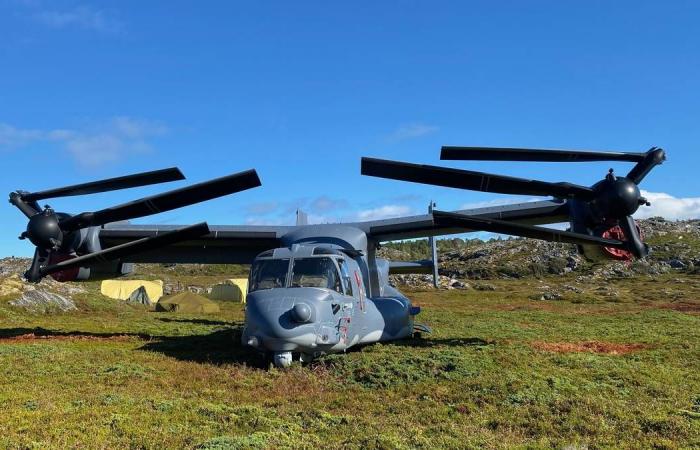On 12 August, an American US Osprey had to make an emergency landing on Sør Senja, and since then the site has been resting.
Now the Norwegian Armed Forces have drawn up a preliminary plan for how they will transport the machine away from the nature reserve at Senja.
– As of now, the sea route is plan A, says chief sergeant for 139 Air Wing in the Maritime Helicopter Wing, Odd Helge Wang.
The Norwegian Defense Forces have been in close dialogue with the State Administrator and used their own environmental officers. In this way, they must ensure that the aircraft is transported out in a way that safeguards nature in the area.
– It is quite complicated to carry out technically, and something neither we nor the Americans have done before, says Wang.
The defense has now sent their plan to the Americans for approval.
– We hope that a decision will be made on their part during this or next week. Once it is taken, it will take about two to three weeks to carry out the operation, says Wang.
Unknown and potentially dangerous error
According to the US Air Force, there was an “unknown and potentially dangerous” fault with the clutch on the aircraft, the website Breaking Defense reported. This should have meant that the power transmission to the engines did not work as it should.
As a result, the aircraft had to make an emergency landing at Senja.
Afterwards, the US Air Force decided to put all its Osprey machines on the ground.
Last winter, a helicopter of the same type crashed in Beiarn in Nordland. This summer, the US Marines concluded that the accident occurred due to pilot error.
Must build road and ramp
Colonel Eirik Stueland tells NRK that both a road, a ramp and a jetty must be built in the nature reserve in order to transport the aircraft out.
The operation will cost a “significant” sum, he says.
– Of course, we must take the reserve into account, and do as little damage as possible to the area.
Now it is just waiting for a decision from the American side whether the operation will be carried out.
Here is Lieutenant Colonel Jeff Westerman in the 352 Special Operations Wing and Colonel Eirik Stueland, head of the Maritime Helicopter Wing at Bardufoss, on an inspection at Senja.
Photo: Linda Pedersen / NRK
Lieutenant Colonel Jeff Westerman in the 352 Special Operations Wing cannot say concretely when the decision will be made on the American side.
– That decision is made by someone higher up in the system than me, so I don’t have a good answer for that, he says to NRK.
– But we are aware that the Norwegian winter will be able to affect the operation.
He also praises the cooperation with the Norwegian defense stationed at Bardufoss.
– We have a very good relationship, says Westermann.
Fear of overturning
According to Wang, the Osprey machine will weigh about 20 tons when it is moved away. Dismantling the aircraft first is not an option.
– Then the machine will become unbalanced and may tip over, he says.
The Norwegian Defense Forces proposes to lay out mats in the terrain, in order to be able to approach the machine without destroying the terrain. But getting it lifted on to a boat will probably be no easy task.
– It is very shallow in the area, so there are problems with getting the barge in far enough. A 70-metre-long crane arm is required, says Wang.
– In addition, we have to take the weather into account. There cannot be waves more than 0.3 meters high or winds of more than seven meters per second.
Chief Sergeant for 139 Air Wing in the Maritime Helicopter Wing, Odd Helge Wang, thinks the operation will cost quite a lot.
Photo: Linda Pedersen / NRK
Expecting a bill in the millions
The defense will not come up with a concrete sum for how much the operation will cost, but that it is not a question of small change.
– We are in an early phase, and are in contact with various players to obtain a price. But there are special vessels that have to be brought in, so it will cost a little, says Wang.
– But are we talking about millions?
– We are probably up in that class, yes. But it is the Americans who have to foot the bill because it is their machine, says Wang.
Until the aircraft is transported away, there is a military guard in the area. There is a military zone 200 meters around the machine, and the Norwegian Armed Forces do not want civilians to travel in the area or take pictures.
It will not be possible to dismantle the aircraft before it is lifted. Thus, it will weigh approximately 20 tonnes.
Photo: The Norwegian Armed Forces
The chief sergeant acknowledges that it is not optimal for a military vessel to land in a protected area, but points out that it was done in an emergency and by the book.
He believes it is important that allies continue to train in similar areas, despite the fact that similar incidents may happen again.
– There is always a risk, but I think that risk must be accepted. It is important that the allies are here and training so that they can come and help us if we need it, says Wang.
– But the number of such incidents is so far low in relation to the great activity that is here.
Tags: defense estimates cost millions transport American Osprey nature reserve Senja NRK Troms Finnmark
-






